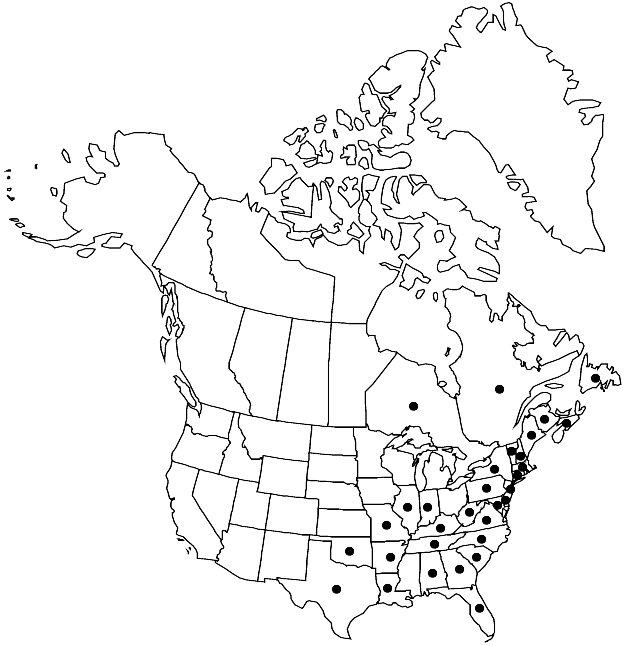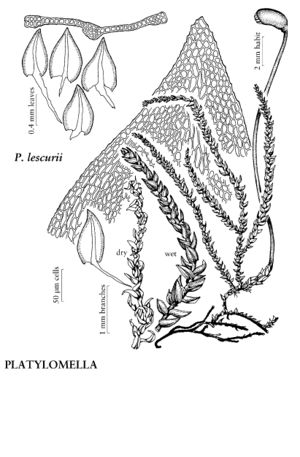Difference between revisions of "Platylomella lescurii"
Bryologist 53: 58. 1950.
FNA>Volume Importer |
FNA>Volume Importer |
Revision as of 19:46, 24 September 2019
Plants in fine sods or loose mats. Stems 1–6(–10) cm, brownish black, prostrate, defoliate proximally, branches 1–2 cm, ascending, simple; paraphyllia becoming scarce in emergent plants; pseudoparaphyllia foliose; rhizoids matted, brown. Stem leaves somewhat contorted when dry, 0.5–1.3(–1.5) mm; limbidia sometimes disappearing before acumen or base, sometimes with spurs extending into lamina; costa 40–60(–75) µm wide at base; basal laminal cell walls thick, sometimes pitted. Perichaetia with leaves lanceolate, 0.5–0.8 mm, margins serrulate, apex acuminate, costate. Seta single, yellow to reddish brown, 1–3 cm, straight or flexuose, tortuose in aquatic plants. Capsule reddish brown, 1.5–3 mm, usually shrunken below mouth when dry; exothecial cells rectangular; stomata superficial; annulus deciduous, 2- or 3-seriate; operculum conic-apiculate; exostome teeth 16, yellowish brown, lanceolate, external surface cross striolate proximally, papillose distally, internal surface trabeculate; endostome pale yellow, basal membrane high, papillose. Calyptra yellow. Spores finely papillose, yellowish brown.
Phenology: Capsules mature spring–early summer.
Habitat: Wet rock, tree roots, rotting wood, base of trees along streams, waterfalls, seeps, submerged or in splash zone, lowland and montane deciduous or mixed deciduous-coniferous forests, acid and calcareous rock
Elevation: low to moderate elevations (0-1500 m)
Distribution

N.B., Nfld. and Labr. (Nfld.), N.S., Ont., Que., Ala., Ark., Conn., Del., Fla., Ga., Ill., Ind., Ky., La., Maine, Md., Mass., Mo., N.H., N.J., N.Y., N.C., Okla., Pa., S.C., Tenn., Tex., Vt., Va., W.Va.
Discussion
Platylomella lescurii is distinguished by its mostly 2-stratose margins, filiform paraphyllia, and saxicolous substrate in streams and seeps. Sciaromium laxirete Abramova & I. I. Abramov, listed provisionally by R. Ochyra (1987) as a synonym of Platylomella lescurii, is known only as a Pliocene fossil from Bashkiria, western Eurasia.
Selected References
None.
